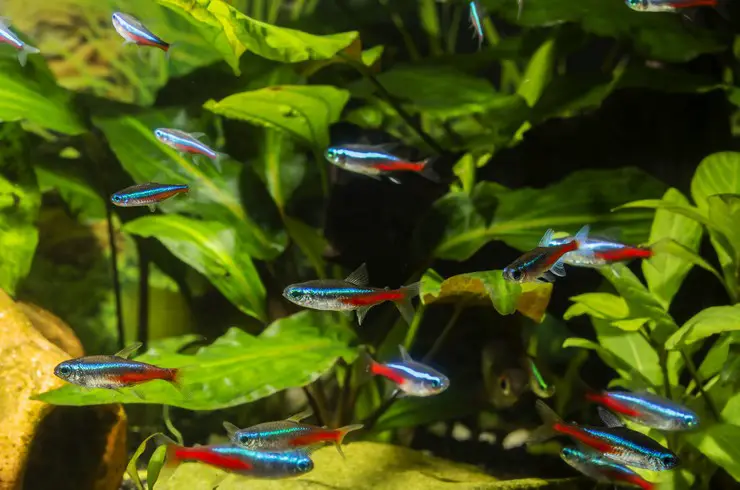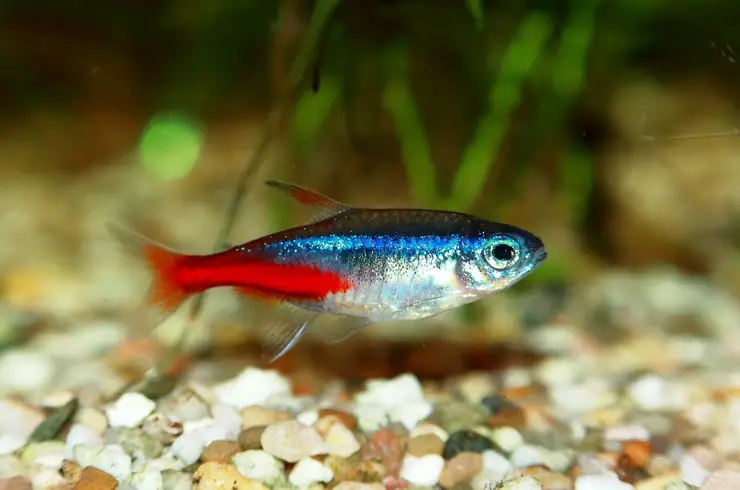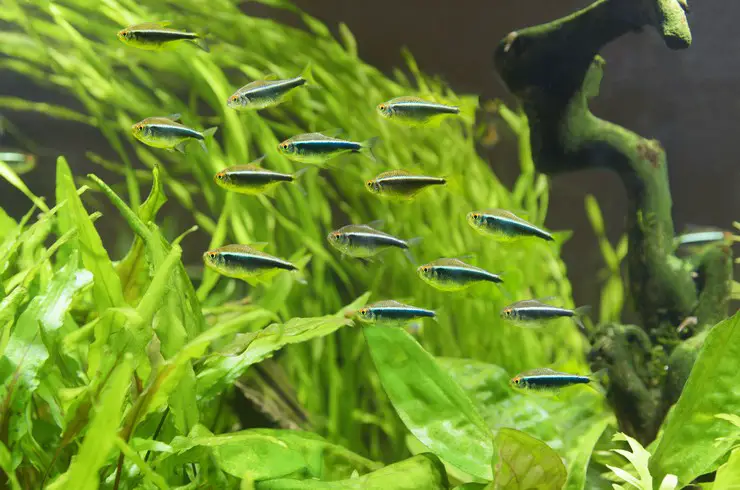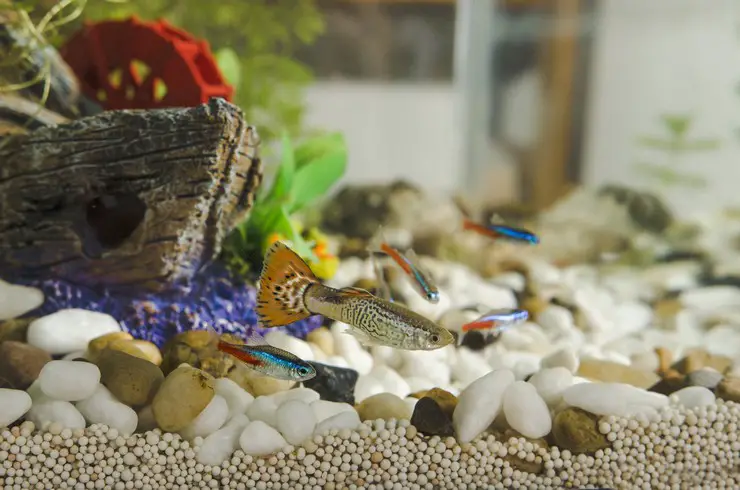Neons are one of the most popular aquarium inhabitants of the Kharacin family. The fish got their unusual name for the characteristic longitudinal stripe on the body, which in the reflected light flares up with glare so bright that it resembles neon advertising signs in cities.
Neon aquarium
It is necessary to contain all types of neons only in flocks of 6-8 individuals. Only in this way will the fish be able to fully reveal their a natural beauty. Single content causes severe stress in neons, which affects color, tone, and longevity.
The most suitable container for keeping a flock of neons would be an aquarium with a volume of 50-60 liters. It should be equipped with a lid so that playful and mobile fish do not accidentally end up on the floor.
If necessary, neons prefer to hide among thickets of aquatic plants. Natural stones and driftwood are best suited for decoration. But you can also put your favorite grotto or castle into the aquarium without problems.
Particular attention should be paid to the equipment when caring for neons. These inhabitants of the Amazon prefer clean water with a low content of nitrogenous compounds, therefore, a filter of suitable power is required, which produces mechanical and biological water purification. Additional aeration will also come in handy, especially at night when living plants do not emit oxygen into the water. And the thermostat will allow you to maintain a temperature comfortable for thermophilic neons at a constant level.
Water parameters
Freshly started aquariums are not the best choice for neons. These fish love well-established and stable water parameters. Therefore, with the launch of neons, it is better not to rush, but to wait several months until the biological balance in the aquarium is fully established.
To create the most comfortable conditions for keeping this brilliant characinaceae, you should pay attention to their natural biotopes in nature. The typical habitat of neons is the slow-flowing rivers of South America, flowing under the arch of a tropical rainforest. A large amount of decomposing organic matter gives the water a rich “tea” hue, makes it acidic, and regular rainy seasons soften the water.
Optimum water parameters for the content:
- Temperature: 23 – 25 °;
- Acidity: 5.5 – 5.7;
- Hardness: 8 – 10.
In order to prevent the accumulation of nitrogenous compounds dangerous for neons, it is necessary to change 20% of the water weekly. It is recommended to prepare the changing water with Tetra AquaSafe. It instantly removes chlorine from water and binds heavy metals, making tap water suitable for fish life. And the vitamins and colloids included in the composition reduce stress and protect the mucous membranes of aquatic inhabitants. The expense of the product is very small – only 5 ml per 10 liters of water.
Tetra ToruMin conditioner will help to make the environment as close to natural as possible. Extraction of natural peat in its composition will enrich the water with useful humic substances and color it in a characteristic “black” color.
Shine
Neons do not accept bright lighting in the best way. Excessively powerful lamps cause stress in fish and the desire to take refuge in a shelter. Therefore, it is beneficial to use floating plant species that provide natural shading.
Priming
Neons do not have special requirements for the soil. Fish live mainly in the middle layers of the aquarium and do not dig at the bottom. You can opt for both coarse quartz sand and small pebbles, which are well suited for plants. It is better if the soil has a dark shade, against such a background neons look brighter and more contrasting.
Plants
In aquariums with neons, zones with live plants are sorely needed. You can create such areas along the walls of the aquarium, leaving a place for swimming in the center. Long-stemmed plants (Vallisneria, elodea, Cabomba, hornwort, etc.) are well suited. Eleocharis, a typical representative of the South American aquatic flora, can be planted at the bottom. The spreading leaves of large Echinodorus and Cryptocoryne will create natural shade. For this purpose, you can also use a floating pistia or riccia.
Feeding the neons
High-quality dry food is great for feeding neons at home. It is not recommended to use frozen and live ones, because they do not contain the whole complex of nutrients and can easily become a source of infection in the aquarium.
Neons are fish with a small mouth, which must be considered when choosing food. You can opt for the following feeds:
- Tetra Micro Crisps is a crisp food for small ornamental fish. Fully balanced contains natural color enhancers and botanicals to support the health and vitality of your fish. Small chips soften quickly, making them easy for neons to eat.
- TetraPro Energy is a portion of highly nutritious food in the form of chips, made using a special low-temperature technology, which allows you to save even more nutrients. At the center of the chips is an energy concentrate to keep your neons always active.
- TetraMin Mini Granules is a basic food for all small tropical fish. The pellets descend slowly, allowing the fish to collect them conveniently. Made from a mixture of more than 40 components of high-quality raw materials. Contains prebiotics for the proper functioning of the digestive tract of fish, and the special BioActive formula supports a healthy immune system.
It is best to feed neons 2-3 times a day with a small portion of food, which will be completely eaten in a couple of minutes. Do not overfeed pets, they are prone to obesity.
Neon compatibility
Neons are one of the best candidates for keeping in community aquariums. These peaceful and calm characin fish get along well with a large number of small ornamental fish species.
Popular viviparous fish (from guppies to swordsmen), cardinals, rasboras, tetras, nannostomuses can be recommended as suitable neighbors. Get along well with apistograms, shrimps, gourami, lalius. You can hook up to other types of neons without fear. Peaceful catfish – ancistrus, corridors – will also not conflict with neons.
But the combination of neons with predatory and territorial fish is strictly contraindicated. Their shiny strip is very attractive for large fish species. Therefore, sooner or later neons will find themselves in the mouth of such a “neighbor”. The general rule when choosing roommates is that neon should not fit into the mouth of another fish.
Neons do not bite off or dig up living plants, so any suitable types of aquatic vegetation can be planted in an aquarium with them.

